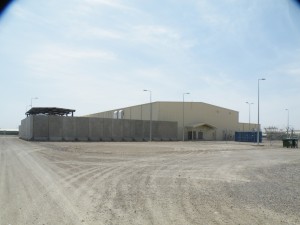Why Did DoD Wait Over Three Months to Issue Records Preservation Order After SIGAR Request?
The $34 million building without a use. (SIGAR photo)
Back in July of last year, SIGAR issued an alert (pdf) regarding what SIGAR head John Sopko termed “a potentially troubling example of waste that requires your immediate attention”. That statement was in Sopko’s cover letter to Defense Secretary Chuck Hagel, Head of Central Command Lloyd Austin and ISAF Commander Joseph Dunford. It would appear that the folks in the Department of Defense missed that key word “immediate”, as the subsequent responses from the Defense Department have been both troubling and, at least on the most important move, slow.
First, to set the stage on the evidence of wasteful spending in constructing a building that had no use at Camp Leatherneck in Helmand province. From the alert letter linked above:
I was told by senior U.S. military officials that the recently completed Regional Command-Southwest (RC-SW) Command and Control Facility, a 64,000 square feet building and related infrastructure with a contract award value of $34 million that was meant to serve as a command headquarters in Helmand to support the surge, will not be occupied. Based on documents provided to SIGAR, it appears that military commanders in Afghanistan determined as early as May 2010 that there was no need for the facility, yet the military still moved ahead with the construction project and continued to purchase equipment and make various improvements to the building in early 2013. Based on these preliminary findings, I am deeply troubled that the military may have spent taxpayer funds on a construction project that should have been stopped.
In addition, I was told that U.S. military officials expect that the building will be either demolished or turned over to the Afghan government as our military presence in Afghanistan declines and Camp Leatherneck is reduced in size. Both alternatives for how to resolve this issue are troubling—destroying a never-occupied and never-used building or turning over what may be a “white elephant” to the Afghan government that it may not have the capacity to sustain. Determining all of the facts on how we reached this $34 million dilemma and what can be done to prevent it from happening again is the reason for sending this management alert letter to you.
Even though the Camp Leatherneck Commander determined in May, 2010 that the building was not needed, construction began anyhow after February of 2011. Ironically, Sopko notes in his letter that this may well be the best-constructed building he has toured in his many inspections in Afghanistan, even though it was known before construction began that there would be no use for the building.
Sopko’s letter continues, citing information collected that the building can accomodate 1200 to 1500 staff but that at the time of writing, only 450 people were available to use it. Furthermore, there was nobody on the base qualified to maintain the expensive HVAC system. But it gets even worse:
According to a senior U.S. military official, as the footprint of Camp Leatherneck decreases, the building could be outside the security perimeter, thereby making it unsafe for the U.S. military to occupy it. This leaves the military with two primary options—demolish the building or give it to the Afghan government.
However, to make it usable for the Afghan government, the building would require a major overhaul of existing systems, including the expensive heating, ventilation, and air conditioning systems. A high-ranking, senior U.S. military official also advised me that the facility was built to U.S. construction standards rather than Afghan standards. For example, the power runs at U.S. 60 cycles versus Afghan 50 cycles and U.S. 120 volts versus Afghan 220 volts. Therefore, it would not be easy to transfer the building to the Afghan government. These were some of the reasons why the U.S. military officials we spoke with believe the building will probably be demolished.
It appears that the Defense Department reacted to Sopko’s letter, because Sopko states in a subsequent letter that he was informed that an investigation was underway and that his questions would be answered. But that process seems to have directly contradicted earlier work from DoD. Sopko wrote a new letter (pdf) to the same recipients on November 27 of last year: Read more →

